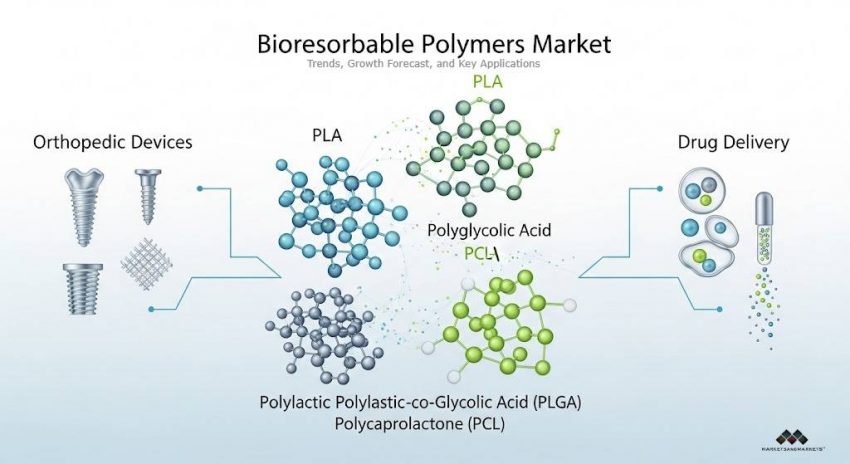In recent years, bioresorbable polymers have transformed the healthcare landscape by offering advanced, biodegradable alternatives to traditional permanent implants. These materials gradually dissolve within the human body, eliminating the need for secondary surgeries and reducing long-term complications. As demand for sustainable, patient-friendly medical solutions accelerates, the bioresorbable polymers market is gaining impressive traction across orthopedic, cardiovascular, and drug delivery applications.
What Are Bioresorbable Polymers?
Bioresorbable polymers—also referred to as bioresorbable or biodegradable plastics—are specialized materials designed to safely break down in the body over time. Common types include polylactic acid (PLA), polyglycolic acid (PGA), polycaprolactone (PCL), and poly(lactic-co-glycolic acid) (PLGA). These polymers are widely used in absorbable sutures, orthopedic screws, coronary stents, and drug-eluting implants.
Unlike traditional implants made of titanium or stainless steel, these materials naturally degrade through hydrolysis or enzymatic action, reducing post-operative risks and improving patient outcomes.
Market Outlook: Strong Growth Ahead
The global bioresorbable polymers market is valued at USD 500.0 million in 2024 and is projected to reach USD 867.2 million by 2029, growing at 11.6% cagr . This growth is largely driven by:
🔹 Rising demand for minimally invasive surgeries
🔹 Growing geriatric population and orthopedic issues
🔹 Expansion of controlled drug delivery systems
🔹 Favorable regulatory frameworks promoting biocompatible materials
Key Application Areas
- Orthopedic Devices
Bioresorbable polymers are extensively used in bone fixation devices, interference screws, pins, and tacks. They provide temporary mechanical support until the bone heals and then naturally dissolve, preventing long-term complications. - Cardiovascular Stents
Bioresorbable vascular scaffolds (BVS) are reshaping cardiovascular treatments. These stents restore blood flow and gradually disappear, reducing risks like late stent thrombosis. - Drug Delivery Systems
These polymers offer sustained and targeted drug release, improving therapeutic outcomes for cancer, cardiovascular, and chronic diseases. Products like PLGA-based microspheres are widely used in injectable treatments. - Wound Management & Sutures
Biodegradable sutures made from PLA, PGA, or PCL have become standard in surgeries, offering infection-free healing without the need for removal.
Material Trends
- Polylactic Acid (PLA): Popular due to its biocompatibility, strength, and renewability. Derived from corn starch or sugarcane, it supports circular economy goals.
- Polycaprolactone (PCL): Known for its flexibility and slow degradation, ideal for long-term applications like dental membranes and soft tissue scaffolds.
- PLGA: Offers tunable degradation rates, making it suitable for precision drug delivery and regenerative medicine.
Challenges & Opportunities
Despite the positive outlook, challenges persist, including:
🔸 High manufacturing costs
🔸 Complex regulatory approvals
🔸 Limited mechanical strength for load-bearing applications
However, innovations in 3D printing, nanotechnology, and bio-based feedstocks are rapidly expanding the capabilities of bioresorbable materials. Companies are also exploring customized implants for individual patients, opening new frontiers in personalized medicine.
Regional Insights
- North America holds the largest market share, led by advanced healthcare infrastructure and R&D in medical devices.
- Europe follows closely, supported by favorable policies and sustainability mandates.
- Asia-Pacific is the fastest-growing region, driven by expanding healthcare access, rising medical tourism, and increasing orthopedic surgeries.
Future Outlook
As healthcare continues to prioritize biocompatibility, patient safety, and sustainability, the bioresorbable polymers market will witness continued growth. Collaborative R&D between medical device manufacturers and material scientists will unlock novel applications—from tissue regeneration to smart drug systems—further pushing the boundaries of what’s possible in modern medicine.

